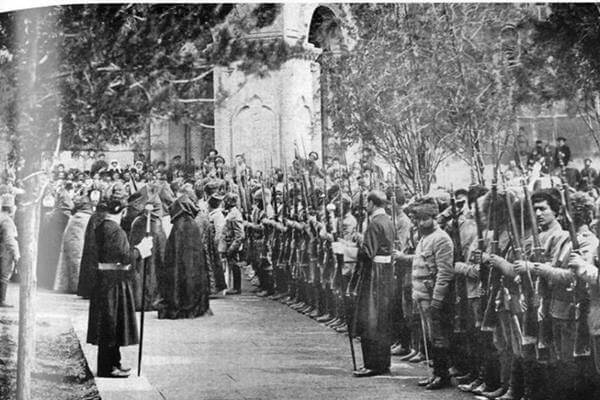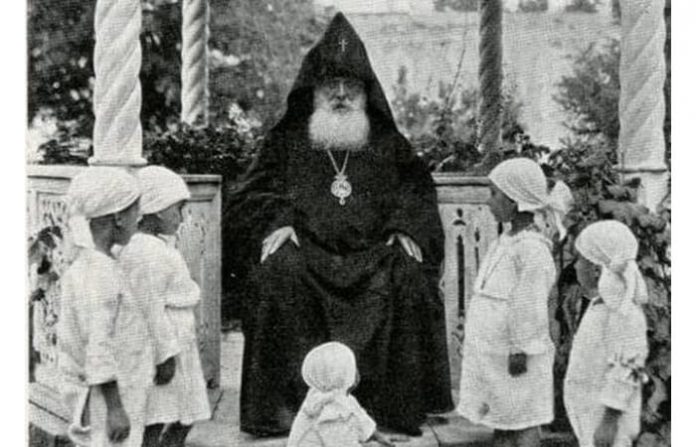(1911-1930)
Sartarabad and First Republic of Armenia
Father ZAVEN ARZOUMANIAN, PhD
The First Republic of Armenia
Despite the destructive World War I, the fall of the Russian Empire, and the immediate rise of the Soviet Union, the first Republic of Armenia on May 28, 1918 was blessed and defended by Catholicos Kevork the Fifth wholeheartedly. The Battle of Sartarabad was under his immediate pontifical protection, and the victory the same year in May 22-26 gave the Catholicos and the nation security with the rise of the First Republic. Soon however, when the new regime of the Soviets dominated under heavy pressures, His Holiness was obligated to defend Armenia no matter what the circumstances compelled, when in fact the communist regime occupied the countries to form the Soviet Socialist Union, including Armenia. His Holiness had to exercise wisdom and diplomacy to defend whatever was left, especially from the hands of the Turks and their invasions. The Catholicos had said, “If we lose what we have, what good is it to have homeland without people.” Against all odds, the Catholicos was valiant to resist the atheist system that he “welcomed” in order to save the nation
The “Sorrowful Catholicos”
The first two decades of His Holiness Kevork V Catholicos of All Armenians coincided with fatal political events for all Armenians in the west and the east, regretfully forcing him to sign his Encyclicals as “Vshdali Gatoghigos” (Sorrowful Catholicos). The Genocide of the Armenians by the Ottoman Turks in 1915 on the one hand, and the Russian Revolution in 1917 followed by the incursions of the Soviet army on the other, covered the skies of our land with darkest clouds in recent history. The Catholicos lamented the loss of churches, schools, towns and villages, as well as the newly proclaimed Republic of Armenia in 1918, its sudden fall, and finally the communist regime that dominated Armenia in 1921. The Catholicos wrote his Pontifical Encyclical in 1921 with fervent prayer that God “may accept our sacrifices in the land of Armenia leaving aside all enmity at this time of great turmoil.”
The Second Decade
Reforms within the Church

The year Armenia went under the Soviet rule in 1921 Catholicos Kevork V had embarked on the second decade of his pontificate. The negative trends of the new system shook the traditional and historical foundations of the Armenian Church fatally, as it did for the Russian and Georgian Orthodox Churches. Rapidly communism revealed its destructive nature, and in the extreme case even at the cost of the life of the next Catholicos Khoren I Mouradbekian. Catholicos Kevork V, who lived through the second decade, stood strong and unshaken, promoting incredibly even some important reforms within the Armenian Church before his demise in 1930.
Among the reforms of prime importance was the formation of the Supreme Spiritual Council that replaced the rules of the previously mandated imperial Polozhenia (Constitution). Seemingly it marked some ”self-administration” of the Armenian Church under the Soviet rule in very limited terms with the latter’s obvious and intimidating control on the Armenian Church affairs. As the executive council, the Supreme Spiritual Council members, clergy and lay, were to be elected by the National Ecclesiastical Assembly according to the new 1925 Constitution drafted by Catholicos Kevork V. The Constitution as of this date remains in force as the law for future elections of the Pontiffs and the members of the Supreme Spiritual Councils.
The 1925 Constitution
The new Constitution was drafted wisely and conclusively regarding the distribution and the election of delegates per capita from all the dioceses in Armenia and abroad. In addition five more reforms were initiated by the Catholicos of All Armenians including the use of the New Gregorian Calendar in 1923 for the Easter Sunday and church feasts, the use of the organ during the celebration of the Divine Liturgy, and only a second marriage of priests whose wives had died during the Armenian massacres. The last ruling however was not well received by the other Hierarchic Sees.
In all, the two decades following the death of Catholicos Kevork V in 1930 until the death of Marshal Stalin in 1953, the Armenian Church suffered unbearable oppressions, exiles and persecution of clergy, leaving the church defenseless and isolated, cutting all contacts and communications with the Armenian churches abroad. Morally devoid, religiously bankrupt, the system exploited everything to degrade the church. The cruel assassination in 1938 of the next Catholicos Khoren I Mouradbekian in Etchmiadzin stands a witness for all times.
Political and Economic Growth
In 1922, the First Assembly of the Union of Soviet Socialist Republics convened in Moscow with representatives of the 15 republics, six of them from Armenia, to form a Central Committee for the state infrastructure which included five members from Armenia, namely, Miasnikyan, Nazaretyan, Ham-bartsumyan, Mirzoyan, and Der Gabrielyan. During Josef Stalin’s presidency the Shirak Dam in Armenia was built in 1925 that helped the agriculture significantly. The same year factories for cotton and textile opened, production of leather, wine, and tobacco bloomed. Soon in 1926 printing presses published books and journals in Yerevan, ten times as much compared with 1913, of course mostly promoting the newly adopted communist ideology.
The economic treaty signed between Russia and Armenia in September 1921 gave boost to house constructions. On a cultural level the Lazarian Armenian Academy of Moscow was named “The Cultural House of Armenia,” and the next year ancient manuscripts belonging to Etchmiadzin temporarily transferred to Moscow, along with printed books. Later, 4660 volumes in total were returned to the Mother See. House constructions rapidly moved forward and in 1926 some 3065 houses were built which in turn helped major cities blossom next to the capital Yerevan, such as Leninakan, Kirovakan, New Bayazit, Dilijan, Goris, and Etchmiadzin. Soviet economy was based on communist system which made the Union’s economy reach higher records at the cost of deprivation of private undertakings. This in turn applied mandatory “brotherhood” among the 15 republics to exchange goods even if Armenia or any of the other republics were deprived of their own productions.
Migration to Armenia
During the pontificate of Catholicos Kevork V and the following decades a wave of migration moved tens of thousands Armenians from the Middle East and Europe to Soviet Armenia for permanent settlement. There were two objectives in this hasty move, first to increase the population of Armenia to meet the Soviet Union’s census requirement and stability, and second to import economic assets in good faith only to be confiscated immediately by the communist government. The false calculation cost immensely to those who migrated heeding to the loud and unreal promises gold-plated with slogans of patriotism. Actually the first migrations from Iraq, Greece, Iran, France and the Middle East proved most untimely, disillusioned to say the least, under tyranny and poverty. Decades later a great majority left Armenia and returned to Europe and the United States with smile on their faces.
Locally settlements of more Armenians in the country in bigger numbers were necessary to balance future perspectives, but the economy and life standard were much lower than they imagined. To help the balance on the positive side, compatriotic suburbs were built instead by their original names from Turkish Armenia, like New Arapkir, New Malatia, New Aintab, and New Kharbert which today are witnesses as good memorials giving lasting comfort to those who sponsored them while living abroad.
Bishops Ordained by Catholicos Kevork V
During his 18 turbulent years the courageous Catholicos of All Armenians made those years fruitful and defended the Armenian Church worldwide as he ordained 30 bishops, some from the Mother See, others from the graduates of the famous Seminary of Armash, near Constantinople, and from the Patriarchate of Jerusalem as needed, despite the unfavorable and oppressive system. Above else, following the horrible years of WWI, the Catholicos extended his helping hand to the Hierarchic Sees outside Armenia, particularly to the ousted See of Cilicia and its defenseless Catholicos Sahak II Khabayan who had settled temporarily in his main diocese of Aleppo.
Upon the recommendation of the Catholicos of All Armenians a generous action was taken in 1929 to transfer from the Patriarchate of Jerusalem three dioceses temporarily over to the jurisdiction of Catholicos Sahak II of Cilicia, as specified in the resolution taken by the Brotherhood of the Patriarchate and personally by Patriarch Yeghishe Tourian himself. Those dioceses were the one in Beirut, Lebanon, and the other two in Damascus and Latakia in Syria. The See of Cilicia thus revived and later settled in Antelias, Lebanon permanently with five dioceses under its jurisdiction, including the dioceses of Aleppo and Cyprus which were the original dioceses of the Great House of Cilicia.
The meritorious bishops ordained by Catholicos Kevork V included Mesrob Naroyan (Patriarch), Nersess Melik-Tangian (Primate), Karekin Hovsepiants (Catholicos), Kevork Chorekjian (Catholicos), Mesrob Neshanian (Patriarch), Grigoris Balakian (Primate), Karekin Khachadourian (Patriarch), and many others. Their credentials confirm both the wisdom of Catholicos Kevork V and the worthy candidates, thirty princes of the Armenian Church in all, who became the champions of the survival and the revival of the Armenian Church and nation through the first half of the most trying 20th century.

